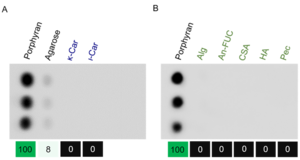CAZypedia celebrates the life of Senior Curator Emeritus Harry Gilbert, a true giant in the field, who passed away in September 2025.
CAZypedia needs your help!
We have many unassigned pages in need of Authors and Responsible Curators. See a page that's out-of-date and just needs a touch-up? - You are also welcome to become a CAZypedian. Here's how.
Scientists at all career stages, including students, are welcome to contribute.
Learn more about CAZypedia's misson here and in this article. Totally new to the CAZy classification? Read this first.
Difference between revisions of "Carbohydrate Binding Module Family 99"
Xuanwei Mei (talk | contribs) |
Xuanwei Mei (talk | contribs) |
||
| Line 18: | Line 18: | ||
== Ligand specificities == | == Ligand specificities == | ||
| + | |||
| + | [[File:Figure1.png|thumb]] | ||
| + | |||
The first characterized member in the CBM99 family is FvCBM99 <cite>Mei2023</cite>. The CBM FvCBM99 could bind to porphyran and displayed a weak affinity to agarose (Fig. 1). While it was incapable of binding to the other examined polysaccharides, including κ-carrageenan, ι-carrageenan, alginate, sulfated fucan, chondroitin sulfate A sodium salt, hyaluronic acid, or pectin. Furthermore, FvCBM99 could bind to porphyran tetrasaccharide with an affinity constant of 1.9 × 10-4 M, but not to agarose tetrasaccharide. Since agarose chains usually contain a few characteristic structural units of porphyran <cite>Chi2012</cite>, it was thus speculated that the weak affinity of FvCBM99 to agarose was attributed to the structural heterogeneity of agarose. The polysaccharide and oligosaccharide binding assays showed that FvCBM99 specifically binds to the major structural units of porphyran. | The first characterized member in the CBM99 family is FvCBM99 <cite>Mei2023</cite>. The CBM FvCBM99 could bind to porphyran and displayed a weak affinity to agarose (Fig. 1). While it was incapable of binding to the other examined polysaccharides, including κ-carrageenan, ι-carrageenan, alginate, sulfated fucan, chondroitin sulfate A sodium salt, hyaluronic acid, or pectin. Furthermore, FvCBM99 could bind to porphyran tetrasaccharide with an affinity constant of 1.9 × 10-4 M, but not to agarose tetrasaccharide. Since agarose chains usually contain a few characteristic structural units of porphyran <cite>Chi2012</cite>, it was thus speculated that the weak affinity of FvCBM99 to agarose was attributed to the structural heterogeneity of agarose. The polysaccharide and oligosaccharide binding assays showed that FvCBM99 specifically binds to the major structural units of porphyran. | ||
| − | + | ||
== Structural Features == | == Structural Features == | ||
The predicted structure by AlphaFold2 showed that FvCBM99 displays a typical β-sandwich fold. | The predicted structure by AlphaFold2 showed that FvCBM99 displays a typical β-sandwich fold. | ||
Revision as of 04:34, 2 January 2024
This page is currently under construction. This means that the Responsible Curator has deemed that the page's content is not quite up to CAZypedia's standards for full public consumption. All information should be considered to be under revision and may be subject to major changes.
| CAZy DB link | |
| https://www.cazy.org/CBM99.html |
Ligand specificities
The first characterized member in the CBM99 family is FvCBM99 [1]. The CBM FvCBM99 could bind to porphyran and displayed a weak affinity to agarose (Fig. 1). While it was incapable of binding to the other examined polysaccharides, including κ-carrageenan, ι-carrageenan, alginate, sulfated fucan, chondroitin sulfate A sodium salt, hyaluronic acid, or pectin. Furthermore, FvCBM99 could bind to porphyran tetrasaccharide with an affinity constant of 1.9 × 10-4 M, but not to agarose tetrasaccharide. Since agarose chains usually contain a few characteristic structural units of porphyran [2], it was thus speculated that the weak affinity of FvCBM99 to agarose was attributed to the structural heterogeneity of agarose. The polysaccharide and oligosaccharide binding assays showed that FvCBM99 specifically binds to the major structural units of porphyran.
Structural Features
The predicted structure by AlphaFold2 showed that FvCBM99 displays a typical β-sandwich fold.
Functionalities
To evaluate the feasibility of FvCBM99 as a tool in the in situ investigation of porphyran, a fluorescent probe was constructed by fusing FvCBM99 with a green fluorescent protein. The in situ visualization of porphyran in red alga Porphyra haitanensis was realized by utilizing the fluorescent probe [1]. Most of the members of the CBM99 family are appended to the GH16_11, GH16_12, GH16_16, or GH16_26 subfamily, or GH86 family. As documented in the CAZy database, members of the four subfamilies and the GH86 family exhibit enzymatic activity for degrading porphyran. It suggests that multiple porphyran-binding CBMs might be present in the CBM99 family. Furthermore, the homologs of FvCBM99, including WP_102755601.1 (located from 770 to 859 amino acids) and WP_108602097.1 (located from 720 to 822 amino acids), were shown to bind to porphyran.
Family Firsts
- First Identified
The first member FvCBM99 is a component of a potential GH86 porphyranase (GenBank: AJW82063.1) from a marine bacterium Flammeovirga sp. OC4 [3].
- First Structural Characterization
No three-dimensional structure has been solved in this CBM family at present.
References
- Mei X, Zhang Y, Liu G, Shen J, Han J, Xue C, Xiao H, and Chang Y. (2023). Characterization of a novel carbohydrate-binding module specifically binding to the major structural units of porphyran. Int J Biol Macromol. 2023;253(Pt 5):127106. DOI:10.1016/j.ijbiomac.2023.127106 |
- Chi WJ, Chang YK, and Hong SK. (2012). Agar degradation by microorganisms and agar-degrading enzymes. Appl Microbiol Biotechnol. 2012;94(4):917-30. DOI:10.1007/s00253-012-4023-2 |
- Liu Y, Yi Z, Cai Y, and Zeng R. (2015). Draft genome sequence of algal polysaccharides degradation bacterium, Flammeovirga sp. OC4. Mar Genomics. 2015;21:21-2. DOI:10.1016/j.margen.2015.02.001 |
